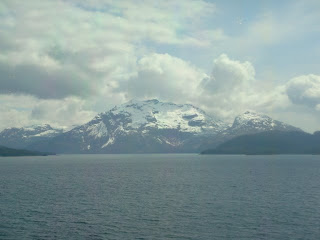The Southwest Islands of the East China Sea stretch like stepping stones from Taiwan to Japan, serving as a bridge between the two cultures (as well as a source of tension as to who should have control over them). In 1372, an Okinawan king began paying tribute to the Chinese court, a practice that continued for over 200 years. However, Japanese power was on the rise by the 17th century, and the Satsuma Kingdom of Southern Kyushu soon invaded and annexed the islands.
Okinawa is the largest and most important island in the group, and Naha (where we docked) is its capital city.


Okinawa was flattened during World War II, and there is little left of the Ryukyu structure. Its most famous attraction, the Shurijo Castle, has since been restored. This had been the residence of the Ryukyu royal family for 450 years. After its restoration based on photographs, historical records and memory, it was reopened in 1993. It served as the venue for G8 Meeting of Heads of State in 2000 (Bill Clinton was there). The entire surrounding area is known as Shuri Park, and was designated a UNESCO World Heritage Site in 2000.

Following our visit to the Castle, we returned to the ship and to Joanna’s favorite spot, the “Bridge.” As you can tell from the photo,

the Captain doesn’t even pay attention anymore to the buttons she is pushing. The Captain, (whose name is Angelo Corsaro, by the way), is the senior Captain aboard the Silversea fleet. As he laughingly likes to say, “the name Corsaro is derived from corsaire, Italian for pirate, so the obvious choice was a life at sea.” Unfortunately, he’ll be leaving us in a few days in Yokohama to continue preparations for the new Silver Spirit, which sets sail in early 2010. It is everyone’s opinion he is training Joanna to take over in his absence…


Anyway, after successfully navigating a departure from the Naha harbor, we enjoyed a farewell dinner with Captain Corsaro and some other Grand Pacific voyagers. (John was there, too, by the way, but he is the one taking the photos).
We are now en route to Nagasaki, Japan
 Visibility was poor when the ship cruised the Hubbard Glacier on Saturday, as there was dense fog in the glacial passage (thus, we don't have great photos).
Visibility was poor when the ship cruised the Hubbard Glacier on Saturday, as there was dense fog in the glacial passage (thus, we don't have great photos).  However, the skies got clear afterward and provided magnificent scenery for the day as we travelled from Valdez to Skagway, Alaska (arriving Sunday morning).
However, the skies got clear afterward and provided magnificent scenery for the day as we travelled from Valdez to Skagway, Alaska (arriving Sunday morning).










































 We also visited the Nagasaki Atomic Bomb Museum, which has numerous artifacts, remains, and photos related to the bombing. It was quite a somber experience to see so much of the devastation caused. That feeling was somewhat tempered when we thought back to our visit to Pearl Harbor; however, it is so unfortunate that either catastrophic event ever had to happen. Seeing Nagasaki rebuilt today, it is hard to imagine that the bombing ever took place. To our surprise, we also found the people of Nagasaki to be among the most hospitable we have encountered, and we enjoyed very memorable sendoffs with musical performances by schoolchildren prior to sailing on. Other children were running up and down the dock waving and holding signs "See you again in Nagasaki!" Adults on the dock were waving with just as much enthusiasm.
We also visited the Nagasaki Atomic Bomb Museum, which has numerous artifacts, remains, and photos related to the bombing. It was quite a somber experience to see so much of the devastation caused. That feeling was somewhat tempered when we thought back to our visit to Pearl Harbor; however, it is so unfortunate that either catastrophic event ever had to happen. Seeing Nagasaki rebuilt today, it is hard to imagine that the bombing ever took place. To our surprise, we also found the people of Nagasaki to be among the most hospitable we have encountered, and we enjoyed very memorable sendoffs with musical performances by schoolchildren prior to sailing on. Other children were running up and down the dock waving and holding signs "See you again in Nagasaki!" Adults on the dock were waving with just as much enthusiasm.






